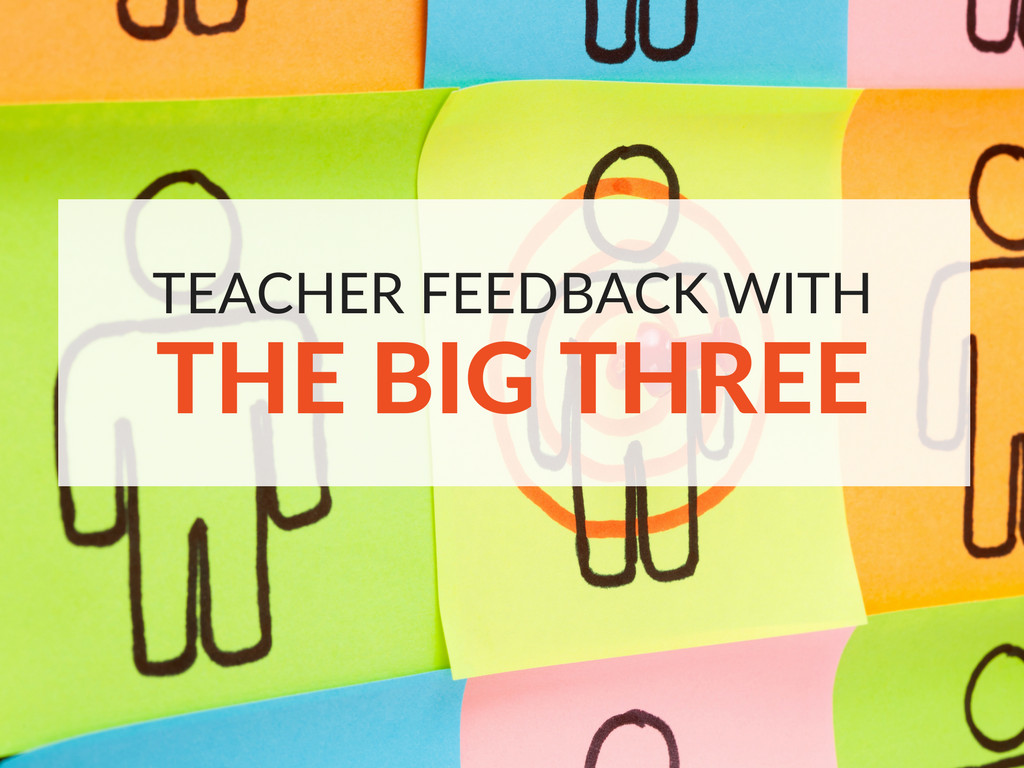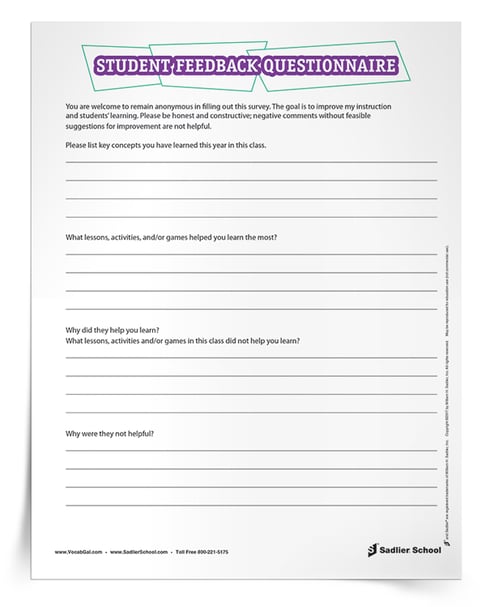May 8, 2018 Vocab Gal, ELA PD - Literacy, ELA K-5, ELA 6-8, ELA Resources - Graphic Organizers, ELA 9-12, ELA Seasonal – End of School Year, ELA PD - Leadership, ELA PD - Classroom Management, ELA PD - Grammar Writing, ELA PD - Vocabulary
The BIG THREE of Teacher Feedback
By: Vocab Gal
In this article, you'll learn how teachers can seek out feedback from their three primary groups of stakeholders: students, colleagues/mentors/administrators, and themselves. Included is a simple Student Feedback Questionnaire teachers can download and use in their own classrooms to get feedback from students.
Every year I like to take a moment, usually during the last week of school when I just can’t grade another paper, to reflect on what worked and didn’t work during the school year. I like to remind myself, teaching is an art, not a science, and artists can only improve after significant practice and plenty of critiques.
Like many of you, during the school year I keep notes as I teach each unit and tweak handouts to make confusing areas clear. I also work on curriculum with my peers, and weed out books that no one is checking out anymore, but it’s often not until the very end of the year that I have a moment to really look back and, then, look forward.

I do love getting student feedback using my end-of-the-year survey, but I will never forget some in-person feedback I received a few years ago.
Without warning, a former student and a friend popped in to say “Hi” during make-up exam time. I had not seen this student in the prior year as she was attending our vocational school full-time, but she came back to thank me. She said “I did not pass your class, and it was clear by January that I was not going to pass your class, but you never gave up on me. You never stopped giving me the assignments and you kept encouraging me to do the work.”
Her words shocked me. I hadn’t realized that continuing to give her assignments and giving her brief words of encouragement could have had such an impact—especially since she did not do or say much when in class.
The idea that my simple gestures were so powerful has led me to reflect deeply on my actions as an educator. To this day, I think about that particular student when I think about how I both design work and treat students in my class; I want everyone to be successful and to feel respected every day, even if there are circumstances beyond my knowledge that are preventing them from succeeding academically.
Why Get Feedback In Education?
Teachers cannot become better if they have no sense of the impact of their teaching on students. Feedback in education allow teachers to identify their strengths and weaknesses. When feedback is received at the end of the school year, areas of weakness can be researched and improved upon over the summer break!
Gathering feedback from students can often be eye-opening. What students remember most from a school year is often not what teachers remember, and sometimes both teachers and students need their memories jogged about what were their most significant learning experiences for the year.
Hopefully, formative and summative assessments are a major part of every teacher’s practice, and the end-of-the-year assessments offer a great deal of feedback to teachers. However, at the end of the year students can become overwhelmed by many summative assessments all at once or may not be as adept at the type of final assessment offered by the teacher. Therefore, a survey, which has no academic consequences for students, can offer insights that the summative work does not.
Additionally, asking for input from respected administrators, colleagues and mentors is invaluable. So often, others in the education profession can offer suggestions and point out aspects of positive and problematic teaching practices that a lone teacher or room full of students cannot recognize. I know that some of the best advice for improving my teaching has come from my colleagues!
Finally, when teachers reflect on their practices it can provide them with a depth of reflection that the everyday “what works and what doesn’t” reflection does not produce. By completing this deeper reflection, teachers can set thoughtful goals for the next school year (which are much better than the hastily put-together goals they might create just before a teacher evaluation conference with an administrator). Teachers can also remind themselves of their areas of strength at the end of the year, when so often we in the profession ask ourselves “Did we accomplish anything this year?”
Important Tips for Getting Feedback in Education1. Remember that all feedback should be taken with a grain of salt; students and teachers/administrators can all feel passionately about learning, and the ways they view events and activities can be colored by outside forces.
2. The more specific a question, the better; when you can, ask follow up “why” type questions to ensure that you get the whole story.
3. Remember to listen without offering excuses. It is often easy to blame other circumstances or to try to counter specific answers. While taking all feedback with a little skepticism, do remember not to explain away constructive feedback that suggests changes are needed.
The BIG THREE Of Teacher Feedback
AREA 1: STUDENT EVALUATION
Each year, it is crucial to get student feedback in order to know what was and was not effective about your teaching during the year. Your students are the people who are with you day in and day out, and they can also offer insights into how your teaching connects with others teachers and classes.
I've created a simple Student Feedback Questionnaire teachers can download and use in their own classrooms to get feedback from students. Download it now and then read on to learn how to use it effectively with students.
I have revised my survey several times, and believe that it asks students for specific feedback in all areas, which will in turn help me design effective lessons. However, this survey cannot be effective without first putting a few protocols in place.
-
ANONYMITY
Although many students will be brutally honest with their teachers, some of the best, most insightful students may worry that their criticism will negatively impact their grades. In order to assure student that you will remain impartial, make surveys anonymous or even consider putting them online so as not to recognize individuals’ handwriting.
-
EXPECTATIONS
Teachers must stress that students should take their time and be thoughtful about their answers. Teachers and students both need to be respectful of one another and recognize that the survey matters.
-
VALUE
Students need to see the value in the survey, both for the teachers and for themselves. As students provide feedback for their teacher, teachers should remind them that they are also gaining self-knowledge about what type of learner they are and how best they learn. By applying this knowledge, students can help themselves learn and study most effectively.
AREA 2: COLLEAGUE, MENTOR AND/OR ADMINISTRATIVE FEEDBACK
Getting meaningful feedback from another teacher, mentor, and/or administrator (ideally, all three) is incredibly valuable. Colleagues in the education field have years of experience and a wealth of knowledge that they can share with others when given the opportunity.
When asking others in your field for feedback and suggestions, not only will teachers receive invaluable help, but such interactions can also develop stronger colleague relationships and strengthen the departmental and school-wide communities, leading to stronger teaching and learning for staff and students. Additionally, as a mentor, I feel that I can learn from and reflect upon my own teaching practices more deeply when discussing educational issues with my mentees. Additionally, as a mentor, I feel like I can learn and reflect upon my own teaching practices more deeply when discussing educational issues with my mentees.
Most teacher evaluation programs have specific formal feedback forms for both parties to fill out, so I think the most important part of these feedback conversations is to make sure that the teacher understands the advice and ideas being given.
Teachers who are being given feedback should not be afraid to ask follow-up, “why” questions and should ask for concrete suggestions for alternative actions and professional development resources to help solve problems as noted in the feedback.
AREA 3: EVALUATING YOURSELF OR INTERNAL EVALUATION
We can only grow through reflection. There are many different rubrics and methods that you can use to self-assess, but these are helpful questions to ask yourself for the year, as regards to various aspects of the teaching profession:
Teaching Skills and Strategies
-
Did you know your content well and communicate that content to students?
-
Did you know the important learning standards and did you convey them to students?
-
Did you ask effective questions that led ALL of the students to think critically about topics?
-
Did you make sure to call on all the students?
-
Did you make sure the students were actively learning, and didn't spend too much time talking?
Classroom Management
-
Did you maintain a positive and motivating environment for learning?
-
Did you emphasize the importance of learning?
-
Did you treat all students with respect?
-
Were the students in class respectful of all classmates?
-
Did you divide students into groups in mixed and leveled ability groupings?
Assessment Methods
-
Did you use formative assessments effectively this year?
-
Did you use summative assessments effectively this year?
-
Did students’ grades accurately reflect their learning and growth?
-
Did you create differentiated assignments for students based on their abilities when possible?
-
Have you worked with colleagues to create common assessments?
Professional Growth, Collaboration and Communication
-
Have you sought out professional development opportunities to gain the resources and knowledge needed to improve?
-
Have you collaborated with colleagues on common assessment, departmental issues, or other community needs?
-
Have you communicated with staff, students, and peers effectively?
-
Overall what have been your biggest successes this year?
-
Overall, what three areas do you feel you want to work on next year?
-
Thinking of your areas of improvement, what goals do you want to set for yourself next year?
In Conclusion
Teachers should make sure they seek out feedback from their three primary groups of stakeholders: students, colleagues/mentors/administrators, and themselves.
Although it may seem obvious, it is important to keep in mind that teachers themselves are hugely important stakeholders in their own success, and also in their own sanity. Do remember, educators, that as much as it is important to reflect on performance and to set goals, it is also equally important to celebrate successes and not be too hard on yourself.
Ultimately, feedback is critical because it not only helps teachers improve, but it also helps students become more metacognitively aware, and it fosters collaborations and communications among colleagues. This is what true teaching is all about.




